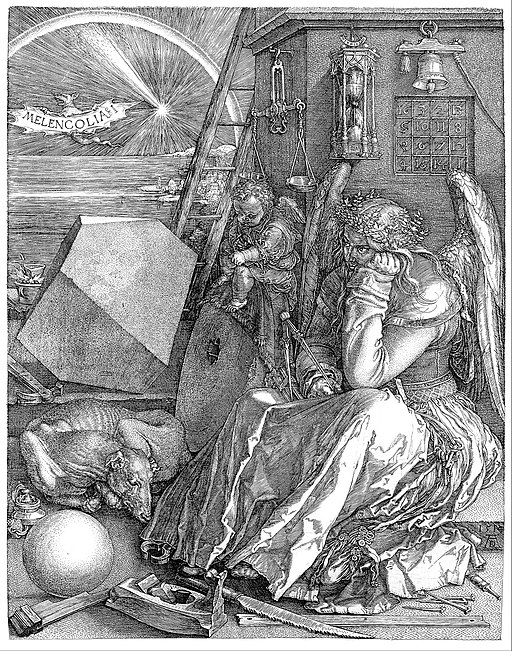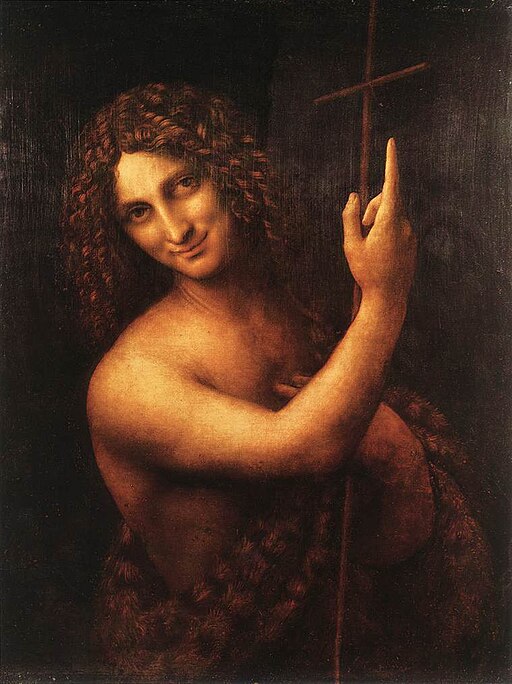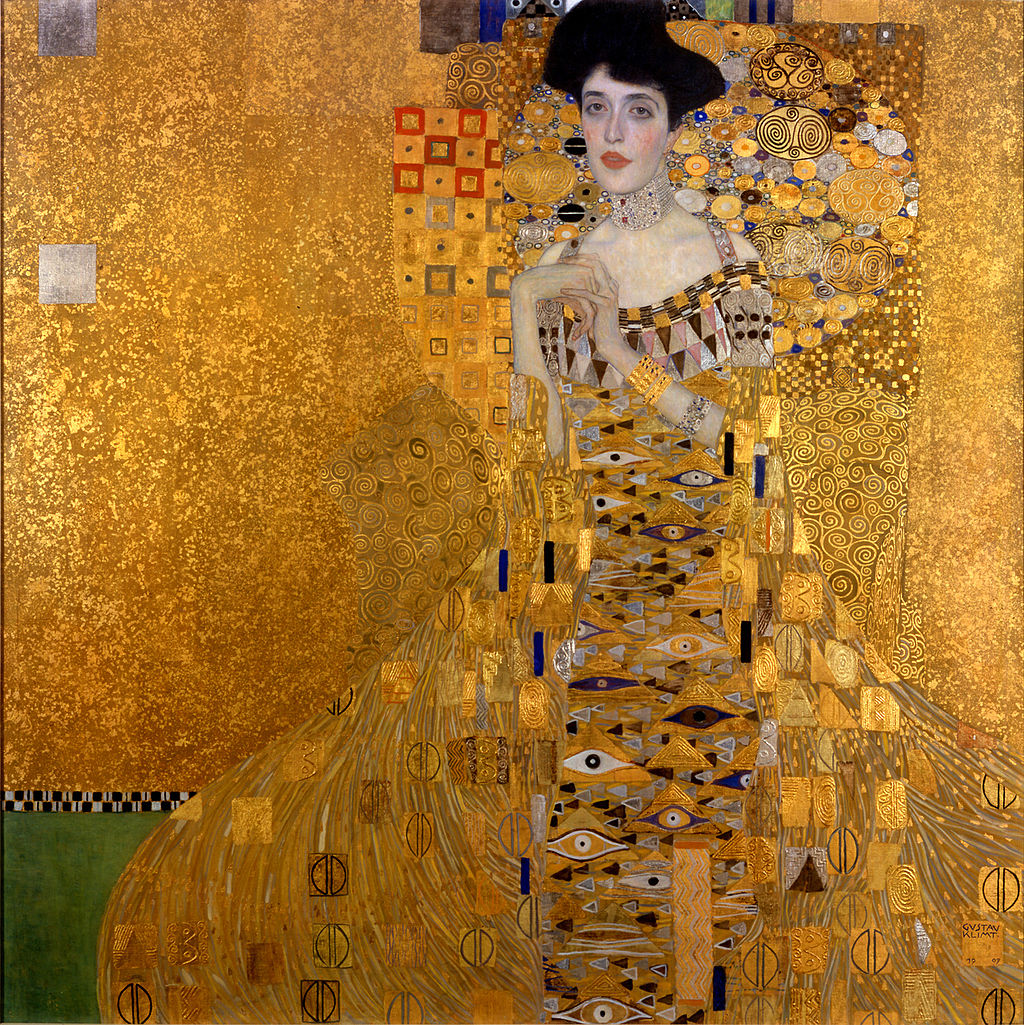
Melencolia I, by Albrecht Dürer, depicts an enigmatic and gloomy winged female figure as a personification of melancholia. Holding her head in her hand, she stares past the busy scene in front of her.
The foreground is strewn with symbols and tools associated with carpentry and craft workshops, including an hourglass, weighing scales, a hand plane, and a saw.
Objects relate to alchemy, geometry, or numerology are also featured. Above and to the right of the figure is a structure with a magic square embedded in the wall.
There is also a ladder against the wall and leading beyond the frame. The sky contains a rainbow, a light source, and a bat-like creature bearing the text “MELENCOLIA I.”
Dürer’s engraving is one of the most well-known old master prints, but, without a definitive interpretation. Dürer may have related melancholia with creative activity.
The woman may be a representation of a Muse, awaiting inspiration but gloomy in the prospect that it will not return.
Some art historians see the figure as pondering the nature of beauty or the value of artistic creativity in the light of rationalism. There is little documentation to provide insight into Dürer’s intent.
Albrecht Dürer’s “Melencolia I” has influenced many artists from the sixteenth century to current times.
The print has attracted the interests of artists, poets, writers, historians, and scientists. Its influence has also extended to The Passion façade of the Sagrada Família, which contains a magic square based on the magic square in Melencolia I.

4×4 Magic Square
On the face of the building is a 4×4 magic square, the first printed in Europe. The two middle cells of the bottom row giving the date of the engraving, 1514, which is also seen above Dürer’s monogram at the bottom right step.
The square follows the traditional rules of magic squares: each of its rows, columns, and diagonals adds to the same number, 34.
The unusual solid that dominates the left half of the image is a truncated rhombohedron.
This shape is now known as Dürer’s Solid, and there have been numerous analyses of its mathematical properties.
Melancholia
Melancholia is a concept from ancient and pre-modern medicine. Melancholy was one of the four temperaments matching the four humors.
During the later 16th and early 17th centuries, a curious cultural and literary cult of melancholia arose in Europe. The origins of this interest in melancholy can be traced to the humanist Marsilio Ficino (1433–1499), who replaced the medieval notion of melancholia into the mark of genius.
Albrecht Dürer
Albrecht Dürer (1471 – 1528) was born in Nuremberg, and his vast body of work includes engravings, prints, altarpieces, portraits and watercolors, and academic books.
Dürer established his reputation across Europe when he was still in his twenties due to his high-quality woodcut prints.
He cultivated communications with the major Italian artists of his time, and from 1512 he was patronized by emperor Maximilian I.
Dürer’s introduced classical motifs into Northern art. Also, through his association with Italian artists and German humanists, he became one of the most important figures of the Northern Renaissance.
His authority was supported by his theoretical treatises, which covered mathematics, perspective, and proportions. Both the Lutheran and Episcopal Churches also commemorate Dürer.
Melencolia I
- Title: Melencolia I
- Artist: Albrecht Dürer
- Year: 1514
- Type: Copper engraving on paper
- Dimensions: Height: 24.1 cm (9.4 ″); Width: 18.7 cm (7.3 ″) (plate & sheet)
- Museum: Art Gallery of South Australia
Albrecht Durer
- Artist: Albrecht Dürer
- Born: 1471 – Nuremberg, Holy Roman Empire
- Died: 1528 (aged 56) – Nuremberg, Holy Roman Empire
- Nationality: German
- Movement: High Renaissance
- Notable works:
- Melencolia I
- Salvator Mundi
- Portrait of Hieronymus Holzschuher
- Portrait of Jakob Muffel
- Self-Portrait at Twenty-Eight
- Self-Portrait with Gloves
- Feast of the Rosary
A Tour of the Art Gallery of South Australia
-
- “A break away!” by Tom Roberts
- “A holiday at Mentone” by Charles Conder
- “Dandenongs from Heidelberg” by Charles Conder
- “A Summer Morning” by Rupert Bunny
- “Circe Invidiosa” by John William Waterhouse
- “The Favorites of the Emperor Honorius” by John William Waterhouse
- Melencolia I by Albrecht Dürer
Dürer’s Enigma: A Kabbalistic Revelation in Melencolia
Dürer’s Melancholia I: How Math and Art can heal
~~~
“Melancholy is the happiness of being sad.”
– Victor Hugo
~~~
Photo Credit: 1) Albrecht Dürer [Public domain]
Popular this Week








 Sponsor your Favorite Page
Sponsor your Favorite Page SEARCH Search for: Search Follow UsJoin – The JOM Membership Program
Sponsor a Masterpiece with YOUR NAME CHOICE for $5
Share this:
- Tweet
